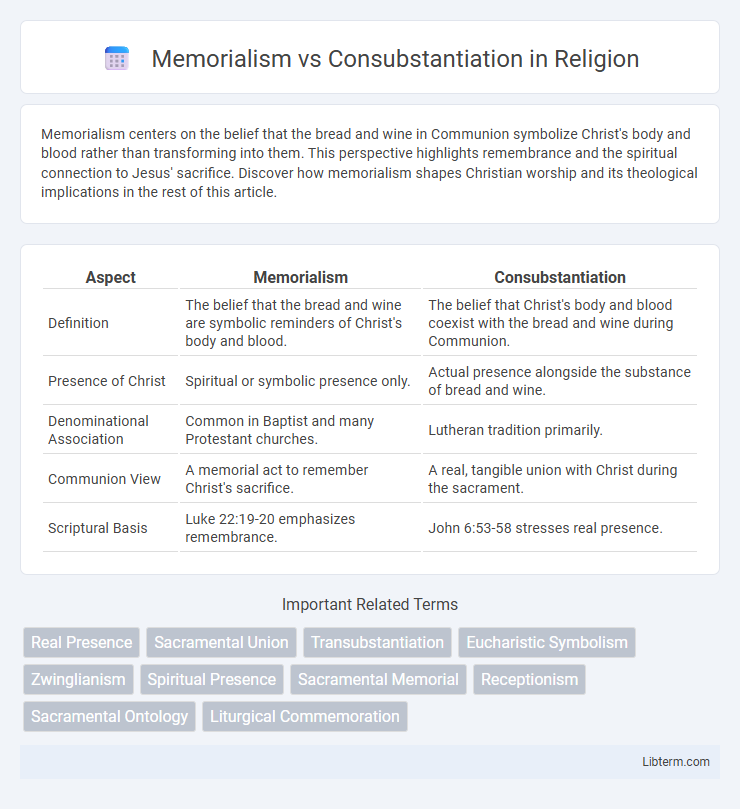Memorialism centers on the belief that the bread and wine in Communion symbolize Christ's body and blood rather than transforming into them. This perspective highlights remembrance and the spiritual connection to Jesus' sacrifice. Discover how memorialism shapes Christian worship and its theological implications in the rest of this article.
Table of Comparison
| Aspect | Memorialism | Consubstantiation |
|---|---|---|
| Definition | The belief that the bread and wine are symbolic reminders of Christ's body and blood. | The belief that Christ's body and blood coexist with the bread and wine during Communion. |
| Presence of Christ | Spiritual or symbolic presence only. | Actual presence alongside the substance of bread and wine. |
| Denominational Association | Common in Baptist and many Protestant churches. | Lutheran tradition primarily. |
| Communion View | A memorial act to remember Christ's sacrifice. | A real, tangible union with Christ during the sacrament. |
| Scriptural Basis | Luke 22:19-20 emphasizes remembrance. | John 6:53-58 stresses real presence. |
Introduction to Memorialism and Consubstantiation
Memorialism teaches that during the Eucharist, the bread and wine are symbolic representations of Christ's body and blood, serving as a memorial of Jesus' sacrifice without any change in their substance. Consubstantiation, primarily associated with certain Lutheran beliefs, holds that Christ's body and blood coexist "in, with, and under" the forms of bread and wine, meaning the elements remain bread and wine while being united with Christ's real presence. These doctrines contrast in their understanding of Christ's presence and the nature of the Eucharistic elements during Communion.
Historical Origins of the Doctrines
Memorialism, rooted in the teachings of reformers like Huldrych Zwingli during the 16th-century Protestant Reformation, emphasizes the Lord's Supper as a symbolic remembrance of Christ's sacrifice. Consubstantiation, associated with Martin Luther, emerged concurrently, asserting the real presence of Christ's body and blood alongside the bread and wine, rejecting the Catholic doctrine of transubstantiation. Both doctrines arose from theological debates challenging medieval sacramental beliefs and seek to reconcile scriptural interpretations with Christological presence in the Eucharist.
Core Beliefs: Memorialism Explained
Memorialism teaches that the bread and wine in Communion are symbols representing Christ's body and blood, emphasizing remembrance without any change in the elements' substance. This view holds that Christ is spiritually present to believers but rejects the idea of a literal or substantial presence in the elements. Memorialism prioritizes the act of commemorating Jesus' sacrifice as a remembrance of His atoning death rather than a sacramental transformation.
Core Beliefs: Consubstantiation Explained
Consubstantiation holds that during Communion, the substance of Christ's body and blood coexist with the bread and wine, maintaining a real, physical presence without transforming the elements entirely. This belief contrasts with Memorialism, which views Communion as a symbolic remembrance without any change in the elements. Consubstantiation, primarily associated with Lutheran theology, emphasizes the mysterious union of Christ's presence "in, with, and under" the forms of bread and wine as a core doctrinal point.
Biblical Foundations and Interpretations
Memorialism emphasizes the Lord's Supper as a symbolic act rooted in Jesus' command at the Last Supper (Luke 22:19), interpreting the bread and wine as representations of Christ's body and blood to commemorate His sacrifice. Consubstantiation, linked to Lutheran theology, asserts the real presence of Christ "in, with, and under" the elements, grounded in scriptural passages such as John 6:53-56 and Matthew 26:26-28, where Christ speaks of His flesh and blood as true nourishment and spiritual sustenance. Both views rely on different hermeneutical approaches to Eucharistic texts, with Memorialism focusing on metaphor and remembrance, and Consubstantiation affirming a mystical union without transforming the elements' substance.
Key Figures and Theological Influences
Memorialism, strongly advocated by Huldrych Zwingli, emphasizes the Eucharist as a symbolic remembrance of Christ's sacrifice, influenced by Reformation humanism and Swiss Protestantism. Consubstantiation, associated with Martin Luther, teaches the real presence of Christ "in, with, and under" the elements of bread and wine, grounded in Lutheran sacramental theology and medieval scholasticism. Both views shaped Protestant sacramental debates, reflecting divergent interpretations of Christ's presence and influenced by key figures like Philip Melanchthon and Johann Eck.
Liturgical Practices and Worship Implications
Memorialism emphasizes symbolic remembrance of Christ's sacrifice during the Lord's Supper, leading to a worship practice centered on reflective observance without belief in Christ's physical presence. Consubstantiation teaches that Christ's body and blood coexist with the bread and wine, resulting in liturgical practices that affirm a real spiritual presence, which shapes a reverent and participatory Eucharistic celebration. These differing theological views influence worship dynamics by either highlighting symbolic memorial or a sacramental union, affecting congregational understanding and liturgical emphasis.
Memorialism vs Consubstantiation: Key Differences
Memorialism teaches that the bread and wine in Communion are symbolic reminders of Christ's body and blood, without any change in substance. Consubstantiation asserts that Christ's body and blood coexist with the bread and wine during the Eucharist, maintaining both substances simultaneously. The key difference lies in Memorialism's symbolic interpretation versus Consubstantiation's belief in a real, sacramental presence alongside the physical elements.
Impact on Modern Christian Denominations
Memorialism, emphasizing the Lord's Supper as a symbolic act of remembrance, profoundly influences Baptist and Zwinglian churches by stressing individual faith and congregational autonomy. Consubstantiation, which teaches the real presence of Christ alongside the bread and wine, shapes Lutheran doctrine and worship practices, reinforcing sacramental grace and continuity with historic liturgy. These differing Eucharistic views impact denominational identity, sacramental theology, and liturgical expression in contemporary Christianity.
Ongoing Debates and Contemporary Perspectives
Memorialism emphasizes the Lord's Supper as a symbolic act of remembrance, asserting that Christ's presence is spiritual rather than physical, a view upheld in many Reformed and Baptist traditions. Consubstantiation, primarily associated with Lutheran theology, holds that Christ's body and blood coexist with the bread and wine, affirming a real, though sacramental, presence during communion. Contemporary debates revolve around the theological implications of presence and substance, with ongoing discussions in ecumenical dialogues aiming to reconcile differing interpretations within Protestant communities.
Memorialism Infographic

 libterm.com
libterm.com